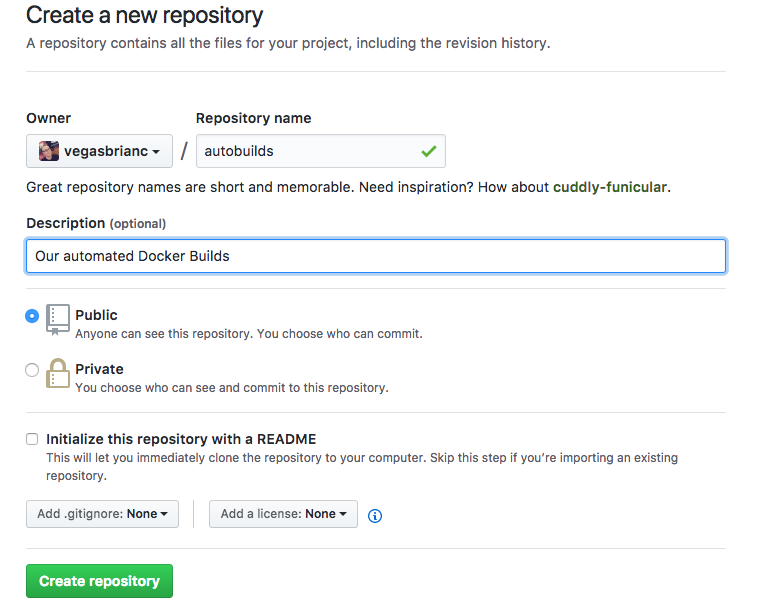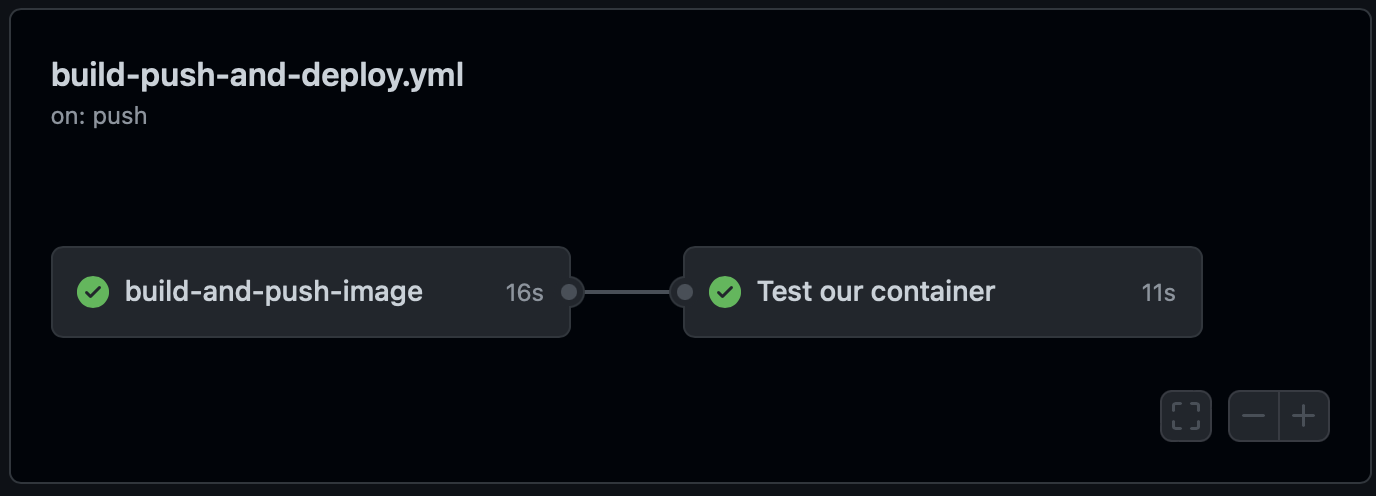Docker and DevOps
Now that we understand how to build Docker images it’s now time to start autobuilding our changes with a pipeline Dockerfile
Tasks:
Task 1: Push your image to Docker Hub
Preparation
-
In order to make commands more copy/paste friendly, export an environment variable containing your DockerID (if you don’t have a DockerID you can get one for free via Docker Hub)
$ export DOCKERID=<your docker id>Special Note: The Windows Command Line does not allow to export the
DOCKERID. You can therefore either directly set the DockerID in the following commands. Or export the variable viaset DOCKERID=<your docker id>and then replace the variable with%DOCKERID%. -
To make sure it stored correctly by echoing it back in the terminal
$ echo $DOCKERID <your docker id>
Push your images to Docker Hub
List the images on your Docker host. You will see that you now have two linux_tweet_app images - one tagged as 1.0 and the other as 2.0.
$ docker image ls
REPOSITORY TAG IMAGE ID CREATED SIZE
vegasbrianc/linux_tweet_app 2.0 01612e05312b 3 minutes ago 108MB
vegasbrianc/linux_tweet_app 1.0 bb32b5783cd3 7 minutes ago 108MB
These images are only stored in your Docker host’s local repository. We want to push these images to Docker Hub so we can access the images from anywhere.
Distribution is built into the Docker platform. You can build images locally and push them to a public or private registry, making them available to other users. Anyone with access can pull that image and run a container from it. The behavior of the app in the container will be the same for everyone, because the image contains the fully-configured app - the only requirements to run it are Linux and Docker.
Docker Hub is the default public registry for Docker images.
-
Before you can push your images, you will need to log into Docker Hub.
$ docker login Username: <your docker id> Password: <your docker id password> Login SucceededYou will need to supply your Docker ID credentials when prompted.
-
Push version
1.0of your web app usingdocker image push.$ docker image push $DOCKERID/linux_tweet_app:1.0 The push refers to a repository [docker.io/<your docker id>/linux_tweet_app] 910e84bcef7a: Pushed 1dee161c8ba4: Pushed 110566462efa: Pushed 305e2b6ef454: Pushed 24e065a5f328: Pushed 1.0: digest: sha256:51e937ec18c7757879722f15fa1044cbfbf2f6b7eaeeb578c7c352baba9aa6dc size: 1363You’ll see the progress as the image is pushed up to hub
-
Now push version
2.0.$ docker image push $DOCKERID/linux_tweet_app:2.0 The push refers to a repository [docker.io/<your docker id>/linux_tweet_app] 0b171f8fbe22: Pushed 70d38c767c00: Pushed 110566462efa: Layer already exists 305e2b6ef454: Layer already exists 24e065a5f328: Layer already exists 2.0: digest: sha256:7c51f77f90b81e5a598a13f129c95543172bae8f5850537225eae0c78e4f3add size: 1363Notice that several lines of the output say
Layer already exists. This is because Docker will leverage read-only layers that are the same as any previously uploaded image layers.You can browse to
https://hub.docker.com/r/<your docker id>/and see your newly-pushed Docker images. These are public repositories, so anyone can pull the images - you don’t even need a Docker ID to pull public images.
Task 2: Setup an Automated Build
Prepare to push our newly created project to GitHub
It’s time to automate our build pipeline. First, we need to create a GitHub Repo.
- Login to your www.GitHub.com account and click create new repository

- Name the new repository
autobuildsand fill in the description in optional

-
From the
linux_tweet_appdirectory, initialize the project, commit, and perform the initial push to GitHub. Follow the directions which GitHub provides as seen below. -
Remove the Git directory
$ rm -Rf .git -
Initialize the Git directory
$ git init -
Change the branch name to main
$ git checkout -b main -
Add your Git Repo configuration to the local index
$ git remote add origin https://github.com/<your GitHub username>/<your github repo name>.git -
Add all files to Git index
$ git add * -
Commit Linux Tweet App files to the GitHub Autobuilds Repo
$ git commit -m "First commit to Autobuilds" -
Push the changes to GitHub
$ git push --set-upstream origin main
Now that we have pushed our project to GitHub, the next step is to enable GitHub Actions to build and push the image.
-
Generate a new Access Token on Docker Hub
Go to the Docker Hub Account Settings -> Security
-
Store the access token and further secrets in the GitHub Repository
Go to Settings -> Secrets -> Actions and add the following Repository Secrets:
- DOCKERHUB_USERNAME:
Your DOCKERID - DOCKERHUB_TOKEN:
The previously created TOKEN
- DOCKERHUB_USERNAME:
-
To add a job, you need to create the
.github/workflows/build-push-and-deploy.ymlfile and add the content below to it:
---
name: Build, Push and Deploy
on:
pull_request:
branches:
- 'main'
push:
branches:
- 'main'
jobs:
build-and-push-image:
runs-on: ubuntu-latest
steps:
- name: Checkout
uses: actions/checkout@v2.3.4
# Configure Docker for Multi-Arch Images
- name: Set up QEMU
uses: docker/setup-qemu-action@v1.2.0
# Login to DockerHub when no pull request
- name: Login to DockerHub
if: github.event_name != 'pull_request'
uses: docker/login-action@v1
with:
username: $
password: $
# Configure the Docker Image Meta Data
- name: Docker Meta
id: docker_meta
uses: docker/metadata-action@v3.4.1
with:
# list of Docker images to use as base name for tags
images: |
$/$
flavor: |
latest=false
tags: |
type=raw,value=latest
# Build and push the image
- name: Build and Push
id: docker_build
uses: docker/build-push-action@v2.6.1
with:
push: $
tags: $
labels: $
- Commit and Push the changes to GitHub
$ git add .github/workflows/build-push-and-deploy.yml
$ git commit -m "Added GitHub Actions Script"
$ git push
- After you pushed the changes go to the Actions tab in your GitHub Repository. You should see the Workflow that was just triggered.
Test Automated Builds
Awesome! To ensure our automated builds are really working let’s commit a new version of our linux_tweet_app to GitHub. When we push our changes to GitHub this will trigger a new GitHub Action Workflow. Great, let’s give it a try.
-
in the
linux_tweet_appdirectory edit theindex.htmlUsing your favorite editor (vi, emacs, etc)
Edit the index.html file and edit line number 33 and change the text to "DevOps is Awesome" $ vi index.html -
Commit our new changes to our GitHub Repo
$ git add index.html $ git commit -m "updated index.html text to DevOps is Awesome" $ git push -
Head back to your GitHub Repository and click on the
Actionstab. You should now see a new Workflow that was just now triggered (Maybe you need to wait a couple of seconds and refresh the page). If you click on the latest Workflow, you get to the Summary page, where you can see thebuild-and-push-imagejob. By clicking on this you can see all the logs and also failures, if something went wrong.
Task 3: Unit Test our Automated Builds
Now, we have an automated Build pipeline in place that is automatically being built every time a new commit is made to GitHub. The next logical step is to add some testing to our project to ensure what we are committing is doing what it is suppose to do.
To do this, we need to add a new job to our GitHub Actions. This will start the previously build container and tries to connect to the HTTP port.
-
Add the following code snippet to your GitHub Actions file:
test-container: name: Test our container needs: build-and-push-image runs-on: ubuntu-latest steps: - name: Checkout uses: actions/checkout@v2.3.4 - name: Test run: | docker container run --detach --publish 8080:80 $/$ docker ps while ! curl --retry 10 --retry-delay 5 -v http://0.0.0.0:8080 >/dev/null; do sleep 1; done -
Commit and push your changes to the GitHub repo
$ git add .github/workflows/build-push-and-deploy.yml $ git commit -m "added testing job to our Autobuild Repo" $ git push -
Head back to the GitHub Actions tab in your GitHub Repository. Select the latest workflow. There you should now see two jobs. After a successful build, you should see the following:

OPTIONAL: Add Build Status to Project

To add the build status to your project, add the following line to your README.md file in your repository root folder.
You can use your favorite editor (vi, emacs, VSCode, etc) to edit the README.md file and paste the following snippet to the first line of the README.md

- Commit the changes to
README.md
$ git add README.md
$ git commit -m "Added GitHub Actions build status to our Repo"
$ git push
Next Steps
For the next step in the tutorial, head over to Deploying an app with Docker Compose